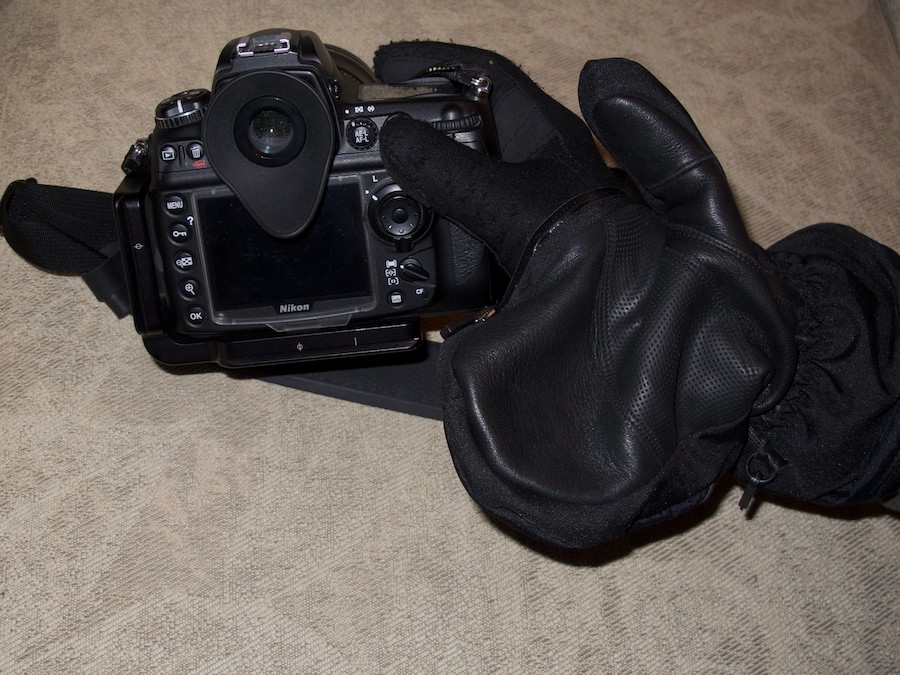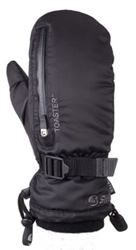
Gloves vs. Mittens for Photography
It’s the age-old debate among photographers: gloves vs. mittens. Which are best for the serious photographer, amateur or pro?
For most photographers, the choice is a matter of preference, since the overwhelming majority of enthusiasts shoot in warm or mildly cold temperatures. In those cases you can get away with a light glove, like the excellent wool gloves made by Lowepro that sport rubberized palms and fingers that give the photographer a good grip. I own a pair that I use through the Fall shooting season.

Many photographers I know prefer mittens, simply slipping them off when it comes time to shoot. But, what about seriously cold weather? What does a photographer do in sustained conditions of -25F? I had an opportunity to test this out on my recent photo expedition to Canada’s striking Yukon Territory, where cold is… well, very, very cold.
Having had frostbitten fingers on more than one occasion in my youth living in Maine, I’m susceptible to repeat experiences, so I’m unusually careful with my hand wear in winter. I also have a doctorate in winter ecology, meaning that I love being outdoors when the temps drop. I have tried every conceivable glove on the market; Gore-tex, insulated, down-filled, fat, skinny, natural, synthetic, 5-finger and 3-finger hybrids. I’ve also tried every mitten imaginable.
What works for me when I’m photographing in severe cold is this: a thin glove under an insulated mitten. That way I can slip off the mitten once I’m ready to shoot and replace it once the deed is done. The problem has always been what to do with the mitten. I’ve tried clipping it to my sleeve (cumbersome), tying it to the other mitten under my jacket (okay, but not great in Arctic conditions) or just taking 4 pairs with me so that as I lose them I just replace them (very costly and definitely not recommended). Finally, I think I have a reasonable solution for my needs.
This was my setup on my latest trip: a layer of very thin Seirus Hyperlite All-Weather gloves- purchased from REI- underneath a pair of mittens made by Swany America (www.swanyamerica.com). Be forewarned that the Seirus Hyperlites will not last more than a season under regular photographic use. All the wheels and buttons we use tend to eventually shred the forefinger material.
The Swany mittens are another matter entirely in terms of durability. They offer a line of mittens known as the Toaster collection, available in both men and women models. What makes the Toaster mittens unique is they have a water-sealed zipper along the side of the mitten, allowing you to unzip, poke your hand through, take care of your camera controls and make the shot, then withdraw into the comfort and warmth of the mitten.

The Swany mittens are ruggedly constructed. I used the Seirus-Swany pairing throughout my Yukon assignment, including dog mushing. On two nights I was out for up to five hours at a time photographing the Northern Lights, with minus 25F temperatures and a slight wind blowing, making it around -30F. The combo worked well for me, although there are some drawbacks that I need to advise you of if you will be facing that kind of cold.

First, the good news. The zippers on the Swany mittens allowed me to remove my hand as needed, then slip my fingers back into the mitten to rewarm between shots. The mitten fabrics- there are two varieties available, synthetic and leather- are highly flexible, so they give you a good grip on the camera. Even the synthetic model has a leather palm pad to give you a better grip. Each mitten also sports a fleece snow cuff, which can be drawn tight with their uni-pull mechanism. There is also a customizable quick-release strap on the back of the hand.
As I mentioned, I’m particularly susceptible to frostbite in my dominant right hand, the one I use for all my camera controls. I found I needed to add a hand-warmer (www.littlehottieswarmers.com) to each mitten after I’d been out for an hour, just standing around, waiting for the skies to light up. I buy these hand-warmers by the box at Costco. They are environmentally safe, inexpensive and work like a charm.
If you haven’t experienced the biting cold of -25F or below, suffice it to say it is brutal and unforgiving. You’ve got to be fully prepared. These mittens are not the most insulated in Swany’s line, but they are a good compromise for photography IF used with the hand warmers.
The second caution I would offer is that the zippers on the Swany mittens can be difficult to grip and close while wearing the other mitten in extreme cold. Swany needs to attend to that by perhaps enlarging the zipper or making it more grippable. Also, remember that a mitten works best if it is not too tight. The air space helps insulate, and you’ll need a little room to allow for the hand warmers, which are pretty slim.
If you want to try the Seirus-Swany solution I developed, you’ll need to choose the Swany Toaster Arctic (TS-16) model. It is strictly a shell-type mitten. The all-leather Toaster Legend II (TS-20) has a built in thin polyester liner glove sewn into the glove, making it impossible to use with the Seirus liner. That would be all well and good if the Swany built-in liner worked for photography. But the liner that comes sewn into the Swany Legend II does not have finger grips, making it difficult to use for controlling the camera wheels and buttons in extreme cold.
All in all, the Swany-Seirus combo worked okay for me but I am still in search of the “perfect” solution.